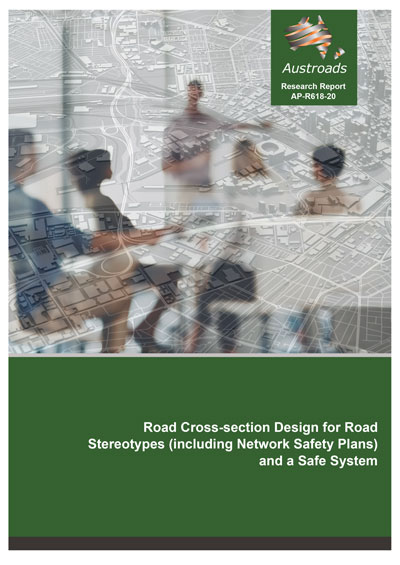Road Design

- Publication no: AP-R618-20
- ISBN: 978-1-925854-97-8
- Published: 18 May 2020
- PDF (free) Download
This report summarises activities undertaken to produce guidance on road cross-section design for road stereotypes during stage 1 and 2 of this project. The guidance enables road managers, planners and designers to achieve improved safety outcomes by applying consistent standards along a road corridor.
Thirteen road stereotypes were identified covering rural and urban roads ranging from freeways/motorways to local access roads. For each stereotype, a range of cross-sections was developed with appropriate attributes. Each cross-section was assessed for crash risk using the International Road Assessment Program (iRAP) and the Australian National Risk Assessment Model (ANRAM).
The tables provide guidance on the expected safety performance, or crash risk, of appropriate cross‑section options for each stereotype. Note that the range of attribute dimensions in the assessment was very limited, so assessment results should be considered as an indication of the safety benefits for the nominated attributes.
This information can be used to develop safety improvement plans on a network/corridor, to reduce crash risk on the network. Network/corridor plans can then inform project scoping decisions.
View the webinar about the guidance.
- Summary
- 1. Introduction
- 1.1 Background
- 1.2 Objectives
- 1.3 Scope
- 2. Literature Review
- 2.1 Assessment Methods
- 2.1.1 Australian National Risk Assessment Model (ANRAM)
- 2.1.2 Star Rating Standard (iRAP)
- 2.1.3 Highway Safety Manual
- 2.2 Preferred Crash Risk Assessment Methods
- 2.1 Assessment Methods
- 3. Consultation with Jurisdictions
- 4. Key Design Considerations for Stereotypes
- 4.1 Road Networks
- 4.2 Principles for Improving a Road Network
- 4.3 Design Principles
- 4.3.1 Self-explaining Road
- 4.3.2 Safe System
- 4.3.3 Road Function and Movement and Place
- 4.3.4 Other Design Principles
- 4.4 Road Design Competence in the Network-wide Design
- 5. Development of Road Stereotype Tables
- 5.1 Road Function and Movement and Place
- 5.2 Road Stereotypes
- 5.3 Road Stereotype Attributes
- 5.4 Road Stereotypes Summary
- 5.5 Greenfield or Brownfield Sites
- 5.6 Design Considerations
- 5.7 Cross-section Attributes
- 5.8 Crash Risk Assessment
- 5.8.1 ANRAM
- 5.8.2 Star Rating Standard (iRAP)
- 5.9 Anomalies
- 5.10 Development of Intersection Tables
- 5.10.1 Types of Intersections
- 6. Feedback from Trials
- 6.1 Development of Training Materials
- 6.2 New South Wales Trial
- 6.3 Sensitivity Analysis for Intersection Tables
- 7. Final Process to Assign Stereotypes
- 7.1 Detailed Procedure
- 7.1.1 Step 1: Preliminary Information Required
- 7.1.2 Step 2: Collect the Data for each Corridor/Link
- 7.1.3 Step 3: Identify the Road Stereotype Table
- 7.1.4 Step 4: Consider Safer (Treatment) Cross-sections for each Funding Scenario
- 7.1.5 Step 5: Recommend Corridor Standards
- 7.2 User Guide
- 7.1 Detailed Procedure
- 8. Further Investigation
- 9. Conclusion
- References
- Appendix A Literature Review Summary
- Appendix B Consultation
- B.1 Workshop Participants
- B.2 Presentation Slides
- B.3 Workshop Handout
- B.4 City of Salisbury Map
- B.5 Blacktown City Council Map
- Appendix C Road Stereotypes Tables
- Appendix D Intersection Stereotype Tables
- Appendix E Fatal and Serious Injury Crash Costs
- E.1 Willingness-to-pay
- E.2 Human Capital
- Appendix F Progress Reports
- F.1 Progress Report 1
- F.2 Progress Report 2
- F.3 Progress Report 3
- F.4 Progress Report 4
